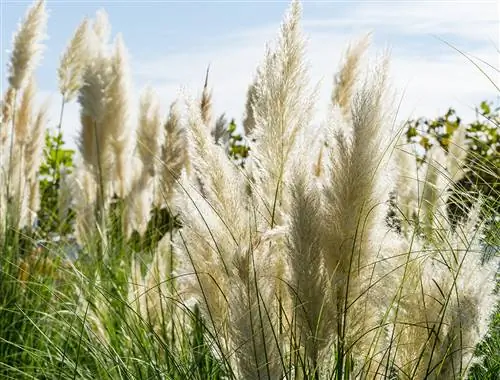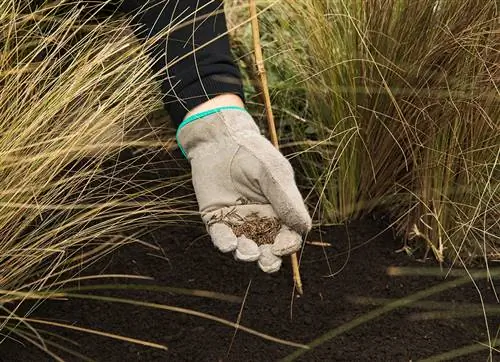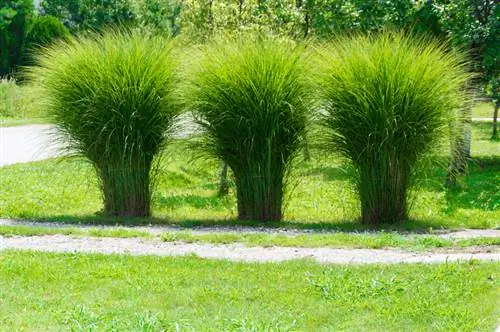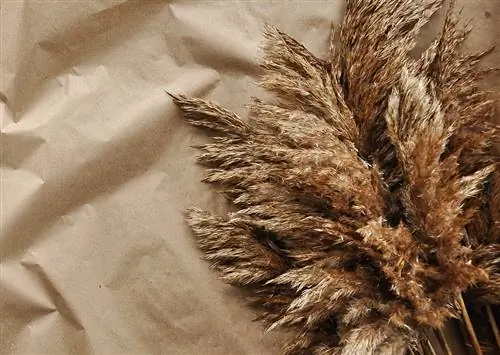- Author admin [email protected].
- Public 2023-12-16 16:46.
- Last modified 2025-06-01 06:02.
In order for the fronds of pampas grass to develop, pampas grass must be properly fertilized - even when planting. The supply of nutrients can be achieved primarily by adding compost to the bed and the bucket.
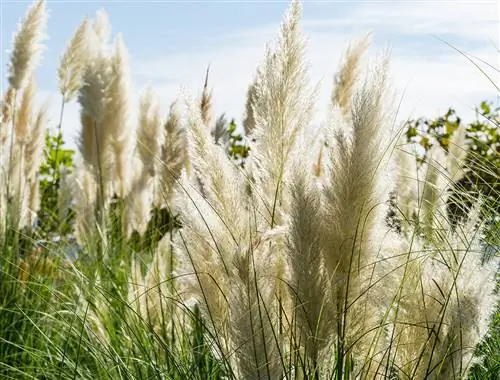
How to fertilize pampas grass?
To properly fertilize pampas grass, you should provide it with organic fertilizer such as compost, horn shavings or coffee grounds in the spring after pruning. Mineral liquid fertilizer is recommended in the bucket about every two weeks.
How to fertilize pampas grass?
Pampas grass is fertilized in spring after pruning. In addition to organic liquid fertilizer for ornamental grasses, compost is also suitable for fertilization. If neither is available, coffee grounds can be used as fertilizer. The fertilizer is incorporated or poured around the plant. Fertilization in summer is not necessary and can be done once after pruning in spring.
Fertilizer for pampas grass
Pampas grass (Cortaderia selloana) originally comes from the moist grasslands of South America. There the impressive solitary perennial finds very humus-rich and loose soil - enough nutrients and space for its deep roots. In order for the popular ornamental grass to thrive in the garden and form large flowers, the plant needs fertilizer.

In nature, the plant material that dries up and dies in winter returns to the nutrient cycle. And thus gives the pampas grass enough energy for the new year. But pruning takes place in the garden in spring. The natural cycle is interrupted. Without fertilizer, the pampas grass grows sparsely and only produces small flowers. A little organic fertilizer and even home remedies will provide the giant grass with enough nutrients again.
Home remedies and organic fertilizers
Coffee grounds have proven particularly useful as a home remedy. Not only is it full of important minerals - potassium, nitrogen, phosphorus - but it also has a low pH value. That's ideal. Pampas grass grows best on slightly acidic soils, which is why the coffee grounds also contribute.
Organic fertilizer refers to nutrient-rich substances of plant or animal origin. They come closest to the natural soil conditions of pampas grass. The advantages of organic fertilizer are, on the one hand, that the soil and groundwater are protected. On the other hand, over-fertilization is almost impossible. In addition, organic fertilizer is usually cheaper and non-toxic. Pampas grass thanks the use of horn shavings and especially compost with decorative flower spikes.
Organic fertilizers for pampas grass:
- Coffee grounds
- Horn shavings
- Compost
Coffee grounds
Fertilization with coffee grounds isonly suitable for the bedIn the bucketit usually molds too quickly. But even before being placed outdoors, the coffee grounds must first dry completely after brewing. A few hours in an open container on the windowsill is enough.
Coffee grounds can be mixed into the soil aboutonce a month from May onwards. If there are brown tips on the blue-green stalks of the pampas grass, it can be a little more. From August onwards, the addition of fertilizer will be stopped. Otherwise the plant will have problems overwintering.
Horn shavings
Horn shavings consist of animal bones, horns, etc. Although it sounds less appetizing, it actually makes a lot of ecological sense. Horn shavings are a waste product of slaughtering and often end up in the trash. Therefore, it is much better to use all parts of the animal. In the garden, the nitrogen-rich horn shavings are primarily used for tomatoes.
In order for plants to benefit from animal fertilizer, it must first be decomposed by microorganisms in the soil. The use of horn shavings is thereforenot suitable for the bucket, as no or only a few decomposers live there. After pruning, a handful of horn shavings are distributed around the plant in the bed. Due to the high nitrogen content, thisone dose in spring is sufficient.
Compost
Compost consists of garden waste that sits around for up to a year. Insects and bacteria process the plant material into fertile humus. The resulting compost is rich in all the important minerals that plants need to grow. It's easy to use: work compost into the soil around the pampas grass. After pruningyou can fertilizeonce with compost.
If you don't have any or not enough of your own compost, you'll find a good replacement in the Plantura compost soil (€10.00 on Amazon) in a 40 liter bag. The high-quality organic compost is an absolute all-rounder in the garden. Tomatoes, cucumbers and many other plants also enjoy peat-free compost.
Mineral liquid fertilizers
Mineral liquid fertilizers are not based on animal or plant material. They are obtained from chemical processes. Its advantages are the many quickly available nutrients and the easy dosage. Their disadvantages, however, consist of damage to the soil and water. They are usually poisonous and often lead to over-fertilization of plants. Pampas grass in particular reacts very sensitively to too much, highly concentrated fertilizer.
Pampas grass outdoors should therefore be fertilized organically. Liquid fertilizer is only recommended if the ornamental grass is growing in a bucket. Because in the limited pot the roots cannot dig deep. Organic fertilizer is also eliminated due to the need for decomposers. And because watering constantly washes away minerals, you have to use liquid fertilizer to help. You can find appropriate ornamental grass fertilizer in stores. The pampas grass in the bucket should be fertilized about every two weeks.
Further care measures
Fertilizing is only part of the species-appropriate care of pampas grass. A sunny location, water-permeable substrate and correct watering behavior are just as important as the right fertilizer. In addition, winter protection must be taken into account: pruning must not take place in autumn or winter.
Location
Pampas grass preferssunny, wind-protected locations outdoors. Ideally on a slightly sloping slope so that water does not collect. To plant, dig a hole that is about twice as deep and wide as the root ball. Sprinkle compost generously in it and then plant the plant.
Basically the same applies to pampas grass in a pot. The pot should hold at least 40 L. have diameter. It is advantageous to place the heavy pot on a roller board beforehand so that the plant remains mobile. Smaller varieties such as “Pumila” are particularly suitable for containers. Ideally, the pot should be placed against the wall of the house to provide additional protection from the wind.
Substrate for pots and beds
The ornamental grass likes it to be nutrient-rich, but above all loose and deep. Therefore, soil that is too hard and loamy outdoors should be loosened up with sand or gravel. Pampas grass in a pot also requires drainage made of expanded clay or coarse gravel. Drainage holes in the bottom of the pot are necessary so that excess water can drain away.

We recommend the bamboo and grass soil from frux as the ideal substrate. It can be used outdoors as well as in a container. The substrate has natural clay, which on the one hand loosens the soil and on the other hand stores water.
Pouring
For planting, the root ball of the pampas grass should be dipped in water and placed wet in the planting hole. Then you should water daily andregularly from frost-free spring onwards. To ensure that the water does not evaporate immediately, watering in the morning or evening is recommended. As a rule, it is better to have a lot than a little often. For pampas grass in the bed, this means around 10 L. Water in the bucket until water comes out of the holes and drains away.
Cutting
Pampas grass needs to be tied together in a bunch for winter protectionbefore the first frost. To do this, the stalks and flower stems are fixed upwards with several straps. Rain flows down the outside of the foliage and does not hit the sensitive clump. Brushwood and leaves can be placed around the grass for additional insulation. Container plants overwinter in a similar manner if they cannot be placed in an unheated greenhouse.
The leaves are essential for winter protection. Accordingly, pruning may only take place in late spring. To do this, the dried stalks and stems are cut off about 20 cm above the clump. Be careful not to remove or damage any fresh green leaves. Pampas grass has very sharp edges, which is why gloves must be worn when cutting.
FAQ
When should pampas grass be fertilized?
Pampas grass is fertilized starting in late spring when the leaves begin to sprout. Fertilization should be stopped from August onwards so that the plant is ready for winter.
Can you fertilize pampas grass with coffee grounds?
Yes, pampas grass can be fertilized with coffee grounds. It is rich in minerals and at the same time has the right pH value. However, coffee grounds should only be used dry and outdoors, otherwise they will quickly become moldy.
What is the best fertilizer for pampas grass?
The best fertilizer for pampas grass is compost. It is cheap, nutrient-rich and very environmentally friendly. Compost is added to the hole when planting and can be worked into the soil several times over the course of the season.
How often is pampas grass fertilized?
Pampas grass in the bed is supplied with an organic fertilizer about once a month. A liquid fertilizer is beneficial in the bucket because minerals are washed out with every watering. To compensate for this, fertilization should be carried out every two weeks.
What fertilizer does pampas grass need?
Pampas grass prefers organic fertilizer. First of all, compost. But horn shavings and home remedies such as coffee grounds can also supply the plant with minerals.
How to fertilize pampas grass?
Compost, coffee grounds and horn shavings must be worked into the soil in the bed - around the pampas grass. Microorganisms then decompose the organic material so that the roots can absorb it. Liquid fertilizer is mixed into the irrigation water in the bucket according to the manufacturer's instructions.

